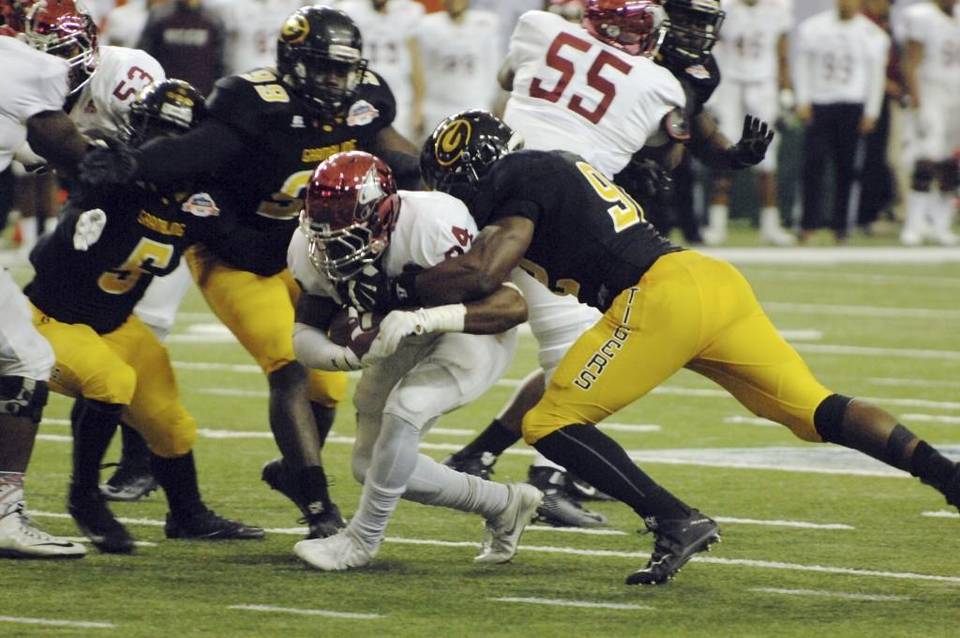
By Paul Newberry
AP Sports Columnist

ATLANTA (AP) – The kickoff to the monthlong bowl season is more than just another game.
For that matter, it goes far beyond the two teams taking the field at noon Saturday.
This is a chance to honor the legacy of all those historically black colleges and universities that played such a vital role in the growth of college football, giving African-Americans a place to play when they didn’t have anywhere else to turn.
Call this a well-deserved celebration, which is why there is no more aptly named postseason game than the Celebration Bowl.
“We wouldn’t be able to do what we’re doing today,” said John Grant, executive director of the game that will be played at the Georgia Dome, “if not for what they did yesterday.”
Indeed, in the days of Jim Crow, HBCUs were a lifeline for African-Americans in the South.
Unless they had the means and opportunity to continue their athletic careers far from home, outside the reach of segregation, blacks were limited to schools such as Grambling State and North Carolina Central, which will meet in this year’s Celebration Bowl.
Grambling, in particular, built a powerhouse program under longtime coach Eddie Robinson, sending countless players to the NFL after they were denied the opportunity to attend whites-only universities such as Alabama and Clemson, which are part of this year’s College Football Playoff.
Of course, those schools now rely heavily on Africa-American athletes. Much like the Negro Leagues in baseball, HBCU athletic programs were hit hard by the collapse of the color line.
The best high school prospects are understandably drawn to the schools that offer the biggest stadiums, the best resources and training facilities, the opportunity to play on national television almost every Saturday, the clearest path to the NFL.
Yet, it’s worth noting that the Mid-Eastern Athletic Conference, the league that North Carolina Central won to claim its spot in the Celebration Bowl opposite Southwestern Athletic Conference champion Grambling State, had three players go in the NFL draft this past spring.
Grant wants to ensure that the legacy of the HBCUs is preserved, while also highlighting all the important things they’re still doing today – on and off the field.
A game that will be nationally televised by ABC, as well as broadcast around the world on the Armed Forces Network, is a huge step in that direction.
“There are good players attending and participating at these universities,” Grant said. “The relevance of these programs is still very strong and viable. It’s our intention to showcase that to the nation.”
As if to show how much this game means to the MEAC and the SWAC, those conferences passed up a chance to send their champions to the NCAA Football Championship Subdivision playoffs. Instead, they’ll play for what’s billed as the HBCU national championship, and it’s hard to argue with the logic.
A year ago, the inaugural Celebration Bowl attracted more than 35,000 fans to the Georgia Dome, as well as a television audience of some 14.6 million viewers, according to Grant.
“An athlete chooses a school to go to because he wants to be seen,” he said. “Now, we have two conferences that have exactly the same platform on national television as every other bowl team. Now, coaches can go out and recruit with the same type of tool that the other schools have, the tool of visibility.”
But this isn’t about putting Grambling on a level playing field with Alabama. That’s never going to happen. The Celebration Bowl is focused on an even bigger goal – ensuring the viability of HBCUs in a time of ever-shrinking government funding and declining enrollments.
Grant said the teams that played in last year’s game, North Carolina A&T and Alcorn State, both received a boost in applications and admissions for the current school year.
“Having a viable athletic program that brings visibility to a school is one of the best student recruiting tools you can have,” he said.
Here’s hoping the Celebration Bowl succeeds where two others have failed. The Pelican Bowl matched the MEAC and SWAC champions in the 1970s, but low attendance doomed that game. The Heritage Bowl came along in the 1990s, but it failed to survive largely because teams could choose to take part instead in the I-AA playoffs, which would leave a league’s second- or even third-best team for the bowl game.
The players seem to realize what’s at stake.
“This game is really important for the history of HBCUs,” said Darius Spruill, a senior defensive tackle at North Carolina Central. “Most people in the world aren’t really focused on HBCUs as much as they should be. I feel like this game brings much-needed exposure to the HBCU football history.”
Grant is focused just as much on the future.
He wants this to be a game that stretches beyond the African-American community. He refers to HBCUs as “some of the most diverse campuses in the country,” with growing numbers of white and Hispanic students. For instance, North Carolina Central’s enrollment of 8,155 students is 12 percent white and nearly 2 percent Hispanic.
“Historically black colleges and universities contribute to the fabric of our nation,” Grant said. “These institutions are critical in ensuring this country is producing quality individuals and access to higher education for everyone, access that is not just at the highest levels.”
Now that’s something worth celebrating.



